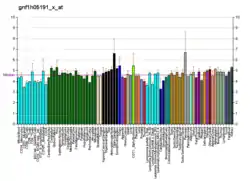GPR144
Probable G-protein coupled receptor 144 is a protein that in humans is encoded by the GPR144 gene.[3][4] This gene encodes a member of the adhesion-GPCR family of receptors. Family members are characterised by an extended extracellular region with a variable number of protein domains coupled to a TM7 domain via a domain known as the GPCR-Autoproteolysis INducing (GAIN) domain.[5][6]
| ADGRD2 | |||||||||||||||||||||||||
|---|---|---|---|---|---|---|---|---|---|---|---|---|---|---|---|---|---|---|---|---|---|---|---|---|---|
| Identifiers | |||||||||||||||||||||||||
| Aliases | ADGRD2, PGR24, GPR144, adhesion G protein-coupled receptor D2 | ||||||||||||||||||||||||
| External IDs | HomoloGene: 130029 GeneCards: ADGRD2 | ||||||||||||||||||||||||
| |||||||||||||||||||||||||
| |||||||||||||||||||||||||
| Orthologs | |||||||||||||||||||||||||
| Species | Human | Mouse | |||||||||||||||||||||||
| Entrez |
| ||||||||||||||||||||||||
| Ensembl |
| ||||||||||||||||||||||||
| UniProt |
|
| |||||||||||||||||||||||
| RefSeq (mRNA) |
| ||||||||||||||||||||||||
| RefSeq (protein) |
|
| |||||||||||||||||||||||
| Location (UCSC) | Chr 9: 124.45 – 124.48 Mb | n/a | |||||||||||||||||||||||
| PubMed search | [2] | n/a | |||||||||||||||||||||||
| Wikidata | |||||||||||||||||||||||||
| |||||||||||||||||||||||||
References
- GRCh38: Ensembl release 89: ENSG00000180264 - Ensembl, May 2017
- "Human PubMed Reference:". National Center for Biotechnology Information, U.S. National Library of Medicine.
- "Entrez Gene: GPR144 G protein-coupled receptor 144".
- Fredriksson R, Lagerstrom MC, Hoglund PJ, Schioth HB (Nov 2002). "Novel human G protein-coupled receptors with long N-terminals containing GPS domains and Ser/Thr-rich regions". FEBS Lett. 531 (3): 407–14. doi:10.1016/S0014-5793(02)03574-3. PMID 12435584. S2CID 7449692.
- Stacey M, Yona S (2011). AdhesionGPCRs: Structure to Function (Advances in Experimental Medicine and Biology). Berlin: Springer. ISBN 978-1-4419-7912-4.
- Araç D, Boucard AA, Bolliger MF, Nguyen J, Soltis SM, Südhof TC, Brunger AT (March 2012). "A novel evolutionarily conserved domain of cell-adhesion GPCRs mediates autoproteolysis". EMBO J. 31 (6): 1364–78. doi:10.1038/emboj.2012.26. PMC 3321182. PMID 22333914.
Further reading
- Vassilatis DK, Hohmann JG, Zeng H, et al. (2003). "The G protein-coupled receptor repertoires of human and mouse". Proc. Natl. Acad. Sci. U.S.A. 100 (8): 4903–8. doi:10.1073/pnas.0230374100. PMC 153653. PMID 12679517.
- Humphray SJ, Oliver K, Hunt AR, et al. (2004). "DNA sequence and analysis of human chromosome 9". Nature. 429 (6990): 369–74. doi:10.1038/nature02465. PMC 2734081. PMID 15164053.
- Bjarnadóttir TK, Fredriksson R, Höglund PJ, et al. (2005). "The human and mouse repertoire of the adhesion family of G-protein-coupled receptors". Genomics. 84 (1): 23–33. doi:10.1016/j.ygeno.2003.12.004. PMID 15203201.
This article is issued from Wikipedia. The text is licensed under Creative Commons - Attribution - Sharealike. Additional terms may apply for the media files.


